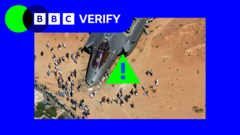Is AI Disinformation Fueling the Israel-Iran Conflict?

## Understanding the Rise of Disinformation in Conflict Scenarios: A Deep Dive
In the digital age, information flows at an unprecedented speed, and this has transformed how we consume news and narratives, especially during conflicts. The recent military actions between Israel and Iran have unleashed a torrent of disinformation that has flooded social media platforms. This phenomenon raises critical questions about the nature of truth, the impact of artificial intelligence on information dissemination, and the responsibilities of social media platforms in curbing misleading content. This article explores the dynamics of disinformation during conflicts, the roles of various actors, and the implications for public perception and policy.
### The Nature of Disinformation
Disinformation refers to false or misleading information that is deliberately spread to deceive others. Unlike misinformation, which is often shared without malicious intent, disinformation is crafted with the aim of manipulating public opinion, creating confusion, or achieving specific political or social objectives. In the context of the recent Israel-Iran conflict, disinformation has taken various forms, including:
- **AI-generated Videos**: Use of artificial intelligence to create fake clips that exaggerate or distort the realities of military engagements.
- **Old Footage Recirculation**: Sharing outdated clips from previous events, repurposed to mislead viewers about current circumstances.
- **Manipulated Images**: Altered photographs that depict false narratives about military capabilities or civilian sentiments.
### The Role of Social Media
Social media platforms have become the battleground for information warfare, where narratives are shaped, contested, and amplified. With millions of users engaging daily, these platforms can facilitate rapid dissemination of content, including disinformation. Key factors influencing this phenomenon include:
1. **Viral Nature of Content**: Posts that evoke strong emotional responses—whether joy, anger, or fear—are more likely to be shared. This behavior creates a feedback loop, amplifying the reach of disinformation.
2. **Algorithmic Amplification**: Social media algorithms prioritize content that generates high engagement, often favoring sensationalist or misleading posts over factual reporting.
3. **Echo Chambers**: Users tend to follow accounts that align with their beliefs, creating environments where disinformation can thrive without challenge.
### Case Study: Recent Events in Israel and Iran
The military strikes initiated by Israel on June 13 have catalyzed a significant increase in disinformation, as evidenced by the activities observed across social media platforms like X (formerly Twitter), TikTok, and Instagram. Here are some notable trends:
#### AI-Generated Content
Numerous videos surfaced alleging to depict Iran's military prowess, showcasing AI-generated imagery of missile attacks on Israeli targets. For instance, one widely viewed clip claimed to show missiles raining down on Tel Aviv, garnering an astonishing 27 million views. However, investigations revealed that:
- Many of these clips were fabricated, often utilizing AI content creation tools.
- Unrealistic elements, such as identical civilian sizes next to vehicles and lack of impact signs, indicated manipulation.
#### Misleading Military Claims
Disinformation campaigns also focused on Israel's military assets, particularly the F-35 fighter jets. Claims circulated that Iran had successfully downed several F-35s, despite the absence of any authentic footage. For instance:
- A video purporting to show a downed F-35 was debunked as being from a flight simulator game.
- Analysts noted that these narratives might be influenced by Russian disinformation tactics, aiming to undermine confidence in Western military technology.
#### Pro-Israeli Disinformation
Conversely, pro-Israeli narratives also exploited disinformation to suggest internal dissent in Iran. AI-generated videos falsely claimed to show Iranians expressing support for Israel, which misrepresented the reality of public sentiment in Iran amidst ongoing military conflict.
### The Motivation Behind Disinformation
The motivations behind disinformation campaigns can be varied and complex. Some key drivers include:
- **Political Objectives**: Nations may engage in disinformation to sway public opinion, undermine adversaries, or bolster their standing domestically and internationally.
- **Financial Incentives**: Social media platforms often reward accounts with large followings, which can incentivize the spread of sensationalist or misleading content for profit.
- **Psychological Factors**: Individuals may share disinformation that aligns with their beliefs or emotions, contributing to the rapid spread of false narratives.
### The Impact of Generative AI
The integration of generative AI in creating disinformation represents a significant shift in how false content is produced and disseminated. Key implications include:
- **Increased Volume and Realism**: AI can produce realistic-looking videos and images at a scale that was previously unimaginable, making it harder for users to discern truth from fiction.
- **Challenges for Verification**: Traditional methods of fact-checking are becoming increasingly inadequate against the sophistication of AI-generated content. This raises concerns about the effectiveness of current verification processes employed by social media platforms.
### Efforts to Combat Disinformation
In response to the rising tide of disinformation, various stakeholders are taking steps to address the issue:
1. **Platform Policies**: Social media companies, including TikTok and X, have implemented community guidelines aimed at identifying and removing misleading content. However, the effectiveness of these measures remains debatable.
2. **Fact-Checking Initiatives**: Organizations dedicated to verifying information are becoming increasingly important in the digital landscape. Their work involves scrutinizing content, debunking false claims, and providing context to users.
3. **Public Awareness Campaigns**: Educating the public about the nature of disinformation and encouraging critical thinking skills is vital. Awareness can empower users to question the sources of information they encounter online.
### The Future of Disinformation in Conflicts
As conflicts continue to unfold in the digital age, the potential for disinformation to shape narratives and influence public perception will likely grow. The challenges posed by AI-generated content and the rapid dissemination capabilities of social media necessitate a multifaceted response involving:
- **Stronger Regulatory Frameworks**: Governments and international bodies need to develop policies that hold social media platforms accountable for the spread of disinformation.
- **Enhanced Collaboration**: Stakeholders, including tech companies, governments, and civil society organizations, must collaborate to create comprehensive strategies to counter disinformation.
- **Continuous Research**: Ongoing research into the mechanisms of disinformation, its psychological impacts, and effective countermeasures is essential to adapt to evolving tactics.
### Conclusion
The surge of disinformation during the Israel-Iran conflict underscores a pressing issue in our increasingly digital world. As we navigate this complex landscape, understanding the nature of disinformation and its implications for public discourse becomes paramount. The responsibility lies not only with social media platforms but also with individuals to foster a culture of critical engagement and media literacy.
In an era where information is both a weapon and a tool, how can we better equip ourselves to discern truth from falsehood?
### FAQs
#### What is disinformation, and how does it differ from misinformation?
Disinformation refers to deliberately false or misleading information spread with the intent to deceive, while misinformation is incorrect information shared without the intent to mislead.
#### How can I identify disinformation online?
Look for signs such as sensationalist language, lack of credible sources, and the presence of AI-generated content. Cross-checking information against trusted news sources can also help.
#### What role does AI play in spreading disinformation?
AI can create highly realistic fake videos and images, making it easier to spread misleading narratives and harder for users to identify false content.
#### How do social media platforms combat disinformation?
Platforms implement community guidelines, engage in fact-checking, and utilize AI tools to detect and remove misleading content. However, the effectiveness of these measures is often debated.
#### What can individuals do to combat disinformation?
Individuals can educate themselves about media literacy, critically evaluate the sources of information they encounter, and share accurate content to help counter false narratives.
### Final Thoughts
The ever-evolving landscape of disinformation demands our attention. As we grapple with the complexities of truth and manipulation in the digital realm, what steps will you take to ensure you’re informed?
#Disinformation #MediaLiteracy #ConflictAnalysis
Published: 2025-06-20 23:47:21 | Category: world



